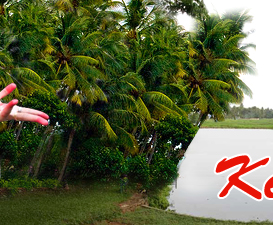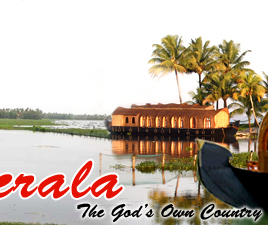Poonjar Palace, situated in Kottayam, in Kerala (India), it is an illustrative example of traditional architecture of Kerala. Explore the article to know all about Poonjar Palace.
Kerala Tourism : Kerala Monuments : Poonjar Palace
Poonjar Palace
Fast Facts
| Location | Poonjar, Kottayam |
| Nearest Airport/Railway Station | Cochin International Airport, Kottayam railway station |
| Best Time to Visit | September - February |
Poonjar Palace, located in Kottayam district of Kerala (India), stands as a glorious evidence of the royal richness of the ancient era. The palace, primarily made of wood, is another rich example of traditional architecture of Kerala. It preserves an exquisite collection of furniture used in the olden times. Here, you can also find a Thoni, huge chandeliers, jewelry boxes, palm leaf engravings and a whole range of lamps. The palace is also home to grain measures, statues, weapons and the sculptures of Nataraja (the dancing Shiva). A unique conch preserved here since years is taken out for ritualistic purposes, only once a year. There are several fascinating aspects related to Poonjar Palace that make it a must-visit monument in Kerala. The Sastha Temple and replica of the Madurai Meenakshi Temple, located in the vicinity of Poonjar Palace, present interesting visual and art imaginary.
History
Poonjar palace was constructed by Poonjar Rajas, ancient dynasty that was associated with Travancore royal family. The palace is about 600 years old, entirely built of wood. Poonjar Palace was the seat of the ancient Poonjar kingdom. The dynasty has an origin from the Pandyan Kings of the Sangam Age. The founder of the Poonjar dynasty was Manavikrama Kulashekhara Perumal, and his mother was a Chera princess. In 1152 AD, they shifted from Madurai after incessant civil wars in Tamil Country. The Raja carried one of the three idols of Meenakshi, their "Kula Devatha", and it was established in the Meenakshi temple on the banks of the Meenachil River.
Manavikraman Raja procured the land from the Thekkancoor Rajas, which is now part of Kottayam, Pathanamthitta and Idukki districts. Erattupetta became the commercial center of the Poonjar kingdom. The area remained as their small principality, till they were leased to the British tea companies two centuries. In 1950s, TATA Tea Ltd acquired the land from Finlays, and the ownership came into dispute after the expiry of the lease. These days, Poonjar Palace has an interesting museum, which exhibits the collection of antiques, rock-cut lamps and several sculptures used during the olden times.
Attractions
Poonjar Palace provides a clear vision of the lifestyle of royal family of Kerala. It is a privileged destination for those who love art and history. It’s beautifully preserved grand chandeliers, Nataraja sculptures and military equipments are quiet fascinating to look at. The palace holds a museum that features the royal collection of antiques, rock-cut lamps, and several sculptures. Near the palace, stands a replica of the Madurai Meenakshi Amman Temple. There are sculptures mounted on the wall of the temple, depicting the stories from the Puranas. Just nearby are beautiful Chuttuvilakku (row of lamps), carved out on the stone walls of the Sastha Temple.
How to Reach
By Air
Cochin International Airport is about 76 km from Kottayam. A number of public as well as private transport ply to and from this airport. So, reaching there is not a problem.
By Road
The place is well connected with the network of road and hence is easily accessible. Traveling by road is a fair bet and economical.
By Rail
The nearest railway station is Kottayam from where you can catch a train to major cities nearby. Travelling by train is safe, convenient and efficient.
History
Poonjar palace was constructed by Poonjar Rajas, ancient dynasty that was associated with Travancore royal family. The palace is about 600 years old, entirely built of wood. Poonjar Palace was the seat of the ancient Poonjar kingdom. The dynasty has an origin from the Pandyan Kings of the Sangam Age. The founder of the Poonjar dynasty was Manavikrama Kulashekhara Perumal, and his mother was a Chera princess. In 1152 AD, they shifted from Madurai after incessant civil wars in Tamil Country. The Raja carried one of the three idols of Meenakshi, their "Kula Devatha", and it was established in the Meenakshi temple on the banks of the Meenachil River.
Manavikraman Raja procured the land from the Thekkancoor Rajas, which is now part of Kottayam, Pathanamthitta and Idukki districts. Erattupetta became the commercial center of the Poonjar kingdom. The area remained as their small principality, till they were leased to the British tea companies two centuries. In 1950s, TATA Tea Ltd acquired the land from Finlays, and the ownership came into dispute after the expiry of the lease. These days, Poonjar Palace has an interesting museum, which exhibits the collection of antiques, rock-cut lamps and several sculptures used during the olden times.
Attractions
Poonjar Palace provides a clear vision of the lifestyle of royal family of Kerala. It is a privileged destination for those who love art and history. It’s beautifully preserved grand chandeliers, Nataraja sculptures and military equipments are quiet fascinating to look at. The palace holds a museum that features the royal collection of antiques, rock-cut lamps, and several sculptures. Near the palace, stands a replica of the Madurai Meenakshi Amman Temple. There are sculptures mounted on the wall of the temple, depicting the stories from the Puranas. Just nearby are beautiful Chuttuvilakku (row of lamps), carved out on the stone walls of the Sastha Temple.
How to Reach
By Air
Cochin International Airport is about 76 km from Kottayam. A number of public as well as private transport ply to and from this airport. So, reaching there is not a problem.
By Road
The place is well connected with the network of road and hence is easily accessible. Traveling by road is a fair bet and economical.
By Rail
The nearest railway station is Kottayam from where you can catch a train to major cities nearby. Travelling by train is safe, convenient and efficient.




